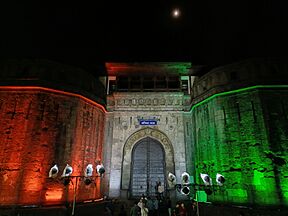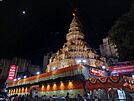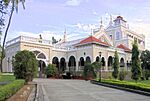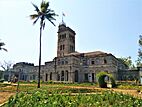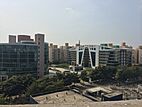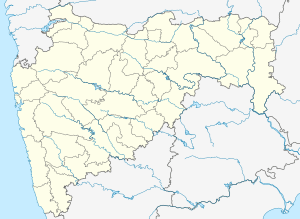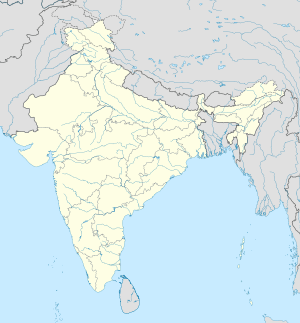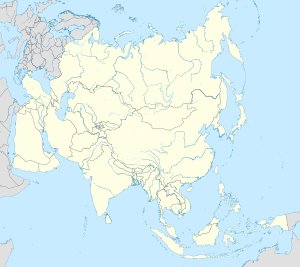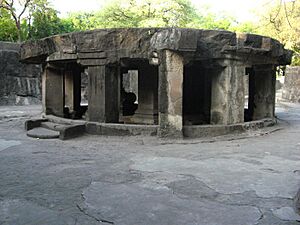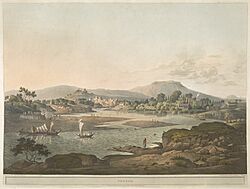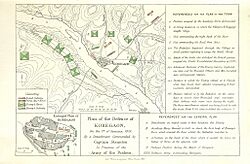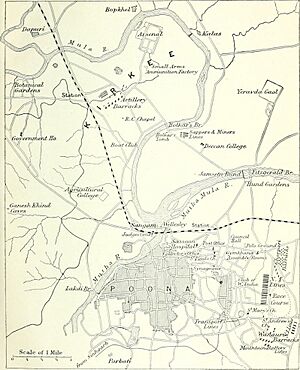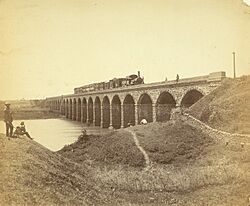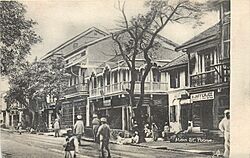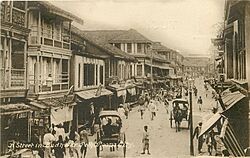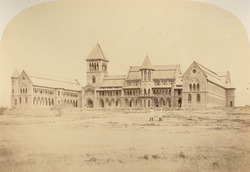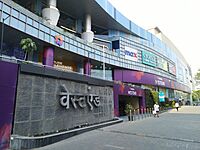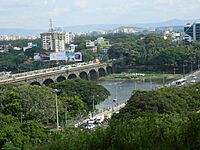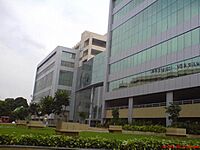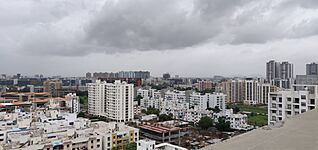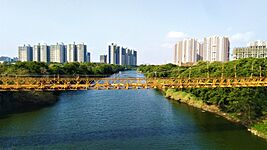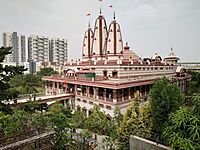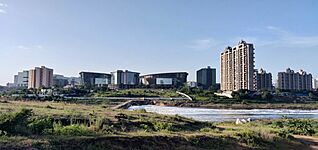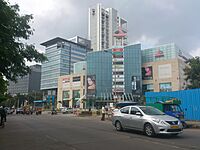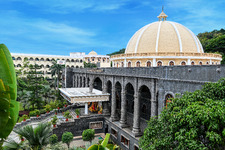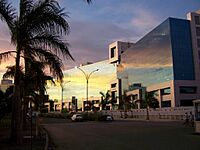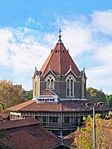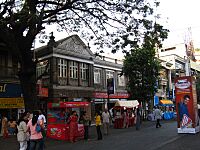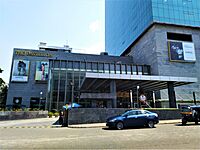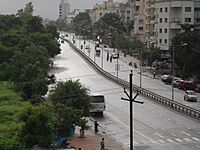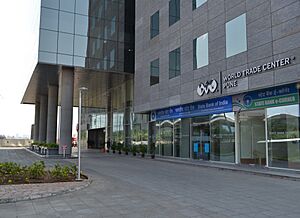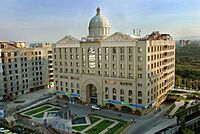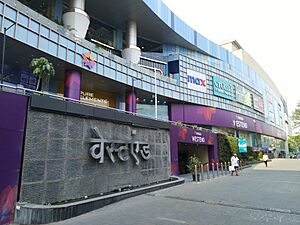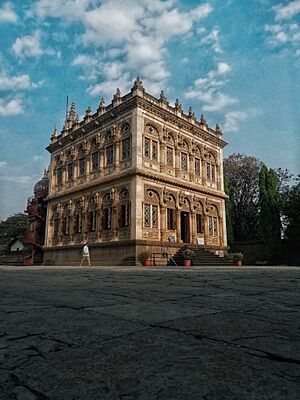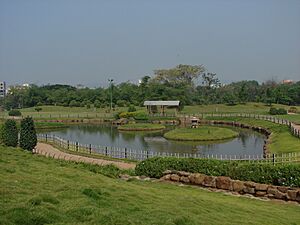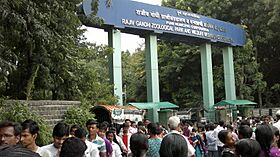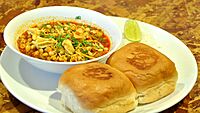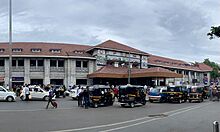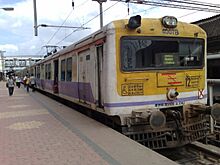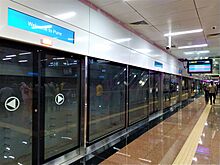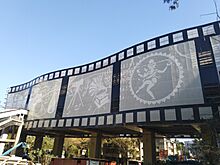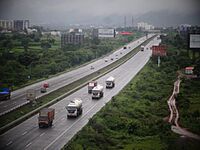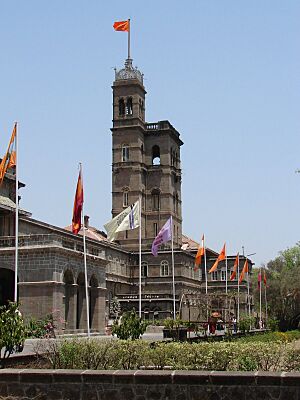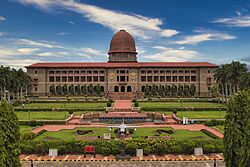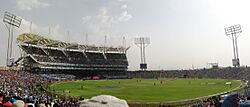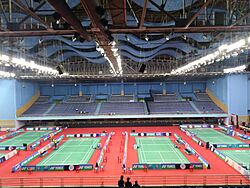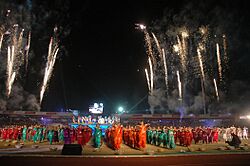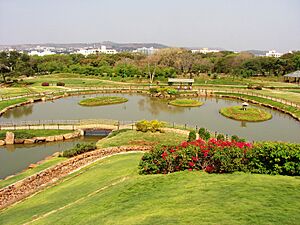Pune facts for kids
Quick facts for kids
Pune
Puṇē
Poona
|
||
|---|---|---|
|
Shaniwar Wada
Dagdusheth Ganapati Temple
Aga Khan Palace
University of Pune
Magarpatta
World Trade Center
Pune West
Chhatrapati Sambhaji Bridge
|
||
|
||
| Nickname(s):
Oxford of the East, The Queen of Deccan
|
||
| Country | ||
| State | ||
| District | Pune district | |
| Division | Pune division | |
| Established | AD 758 | |
| Government | ||
| • Type | Municipal Corporation
|
|
| Area | ||
| • Pune MC | 484.61 km2 (187.11 sq mi) | |
| • Pune MR | 7,256.46 km2 (2,801.73 sq mi) | |
| Elevation | 570.62 m (1,872.11 ft) | |
| Population | ||
| • Pune MC | 6,200,000 | |
| • Pune MC density | 12,790/km2 (33,140/sq mi) | |
| • Pune MR | 7,276,000 | |
| • Pune MR density | 1,002.69/km2 (2,596.96/sq mi) | |
| Demonym(s) | Punekar, Poonaite | |
| Time zone | UTC+5:30 (IST) | |
| PIN Code(s) |
411001 – 411090
|
|
| Area code(s) | 020 | |
| Vehicle registration |
|
|
| Member of Parliament | Murlidhar Mohol | |
| GDP | $69 billion | |
| International airports | Pune International Airport (PNQ) | |
| Transit | Rapid Transit: Pune Metro Commuter rail: Pune Suburban Railway BRTS: PMPML |
|
| Urban Planning Authority | Pune Metropolitan Region Development Authority | |
Pune (/ˈpuːnə/ POO-nə, Marathi: [ˈpuɳe], ISO: Puṇē), also known as Poona until 1978, is a big city in the Maharashtra state of Western India. It sits on the Deccan Plateau. Pune is the main city for the Pune district and Pune division.
With about 7.2 million people in its wider metropolitan area, Pune is one of India's largest cities. It is a major center for IT and car manufacturing. Pune is often called the "Oxford of the East" because it has many excellent schools and colleges. It has also been named "the most liveable city in India" many times.
Over time, different groups have ruled Pune, including the Rashtrakuta dynasty, Ahmadnagar Sultanate, Mughals, and Adil Shahi dynasty. In the 1700s, Pune was an important part of the Maratha Empire. It was the home of the Peshwas, who were like prime ministers of the Maratha Empire. The British East India Company took control of Pune in 1818. Pune became a municipality in 1858 when British rule began. Many old buildings like Shaniwarwada, Shinde Chhatri, and Vishrambaug Wada are from this time.
Pune has always been a major cultural hub. Many important people, like Shivaji and Mahatma Jyotirao Phule, lived and worked here. Pune was also a key place for fighting against British rule. Leaders like Bal Gangadhar Tilak helped lead the fight for India's freedom.
Contents
What's in a Name?
The name Pune has a long history. The oldest mention of Pune is from 937 CE. It was called Punya-Vishaya, which means 'sacred news'. By the 1200s, it was known as Punawadi.
During the Rashtrakuta Dynasty, the city was called Punnaka and Punyapur. Later, the Yadava dynasty named it Punakavishaya and Punya Vishaya. 'Vishaya' means land, and 'Punaka' or 'Punya' means holy. When Shivaji's father, Shahaji, ruled, it was known as Kasbe Pune. For a short time (1703-1705), Mughal emperor Aurangzeb renamed a small part of the city Muhiyabad. But the original name returned after he died. The British called it Poona from 1857 until 1978, when its name officially changed back to Pune.
A Look Back: Pune's History
![]() Maratha Empire 1674–1818
Maratha Empire 1674–1818
![]() Bombay Presidency 1818–1947
Bombay Presidency 1818–1947
![]() Bombay State 1947–1960
Bombay State 1947–1960
![]() Maharashtra 1960–Present
Maharashtra 1960–Present
Early Times and Medieval Period
Old copper plates from the 800s show that a farming village called Punnaka existed where Pune is today. The Rashtrakuta dynasty ruled this area. The Pataleshwar rock-cut temple was built during this time. Pune was then controlled by the Seuna Yadavas of Devagiri until 1327. After that, various Muslim rulers controlled Pune until the late 1600s.
The Maratha Empire and Peshwa Rule
In 1599, Pune became part of a land grant given to Maloji Bhosale by the Ahmadnagar Sultanate. His son, Shahaji Bhosale, inherited it. In 1636, a general from the Adil Shahi dynasty destroyed the town. Shahaji later got Pune back and chose it as the home for his wife, Jijabai, and young son, Shivaji. Shivaji later founded the Maratha Empire.
Dadoji Konddeo helped Jijabai rebuild the town. The Lal Mahal, where Jijabai and Shivaji lived, was finished in 1640. Jijabai also asked for the Kasba Ganapati temple to be built. The Ganesh idol in this temple is seen as the city's main deity. Pune was often fought over by the Mughals and Marathas in the 1600s.
In 1720, Baji Rao I became the Peshwa (prime minister) of the Maratha Empire. He moved his base to Pune in 1728, which helped the town grow into a city. He also built the Shaniwar Wada palace. His son, Nanasaheb, built a lake at Katraj and an underground water system to bring water to the city.
The Peshwas helped Pune grow a lot. They built about 250 temples and bridges. This made religion a big part of the city's economy. Nanasaheb Peshwa also developed new areas for business and homes, like Sadashiv Peth and Nana Peth. The Peshwa's power lessened after the Battle of Panipat, but Pune remained important. In 1802, Yashwantrao Holkar captured Pune, leading to the Second Anglo-Maratha War. The Peshwa rule ended in 1818 when the British defeated Bajirao II.
British Rule (1818–1947)
The Third Anglo-Maratha War began in 1817. The British defeated the Peshwas near Pune and took control of the city. They set up a large military camp, or cantonment, east of the city. This area was developed like a European town for the British military. The old city kept its narrow lanes.
Pune became the "Monsoon capital" for the Governor of Bombay because of its cooler weather. This made it a very important city in the Bombay Presidency. The Southern Command of the Indian Army is still based in Pune.
The city was known as Poona during British rule. The Poona Municipality was created in 1858. A railway line from Mumbai to Pune opened in 1858. New areas like Navi Peth and Ganj Peth (now Mahatma Phule Peth) were also developed.
Pune's Role in Social Change and Freedom
Pune was a key place for India's fight for freedom. From 1875 to 1910, leaders like Gopal Krishna Gokhale and Bal Gangadhar Tilak led protests here. Pune was also a center for social reform. People like Mahatma Jyotirao Phule and Dhondo Keshav Karve worked to end caste prejudice, gain equal rights for women, and improve schools for the poor.
Mahatma Gandhi was held in Yerwada Central Jail and later under house arrest at the Aga Khan Palace from 1942 to 1944. His wife, Kasturba Gandhi, died there.
Pune After India's Independence
After India gained independence in 1947, Pune grew a lot and became a modern city. The Poona Municipal Council became the Pune Municipal Corporation (PMC) in 1950. Education continued to grow with the Savitribai Phule Pune University opening in 1949.
Industrial growth began in the 1950s with companies like Hindustan Antibiotics. In the 1970s, many engineering companies started here. In the 1990s, Pune attracted foreign investment, especially in IT and engineering. IT parks were built in areas like Hinjawadi and Kharadi. This brought many people to the city for jobs.
In 1961, a flood from the Panshet dam caused damage, leading to new suburbs being built. The Pune Metropolitan Region was created in 1967 to help with urban planning.
The six-lane Mumbai-Pune expressway was finished in 2001, making travel to Mumbai much faster. In 2008, Pune hosted the Commonwealth Youth Games, which helped develop the city's northwest.
Where is Pune?
Pune is located in Western India, about 149 km (93 miles) south-east of Mumbai. It sits on the western edge of the Deccan plateau, about 560 meters (1,837 feet) above sea level. It's a hilly city, with Vetal Hill reaching about 800 meters (2,625 feet).
The old part of Pune is where the Mula and Mutha rivers meet. Other rivers like the Pavana and Indrayani river also flow through parts of Pune.
Pune's City Layout
Modern Pune has many different areas. These include the old city's peths (neighborhoods), the British-built military areas of Khadki and Camp, and many suburbs. Industrial growth led to new areas like Pimpri and Chinchwad forming their own municipal corporation.
The Pune Metropolitan Region (PMR) is very large, covering 7,256 square kilometers (2,802 square miles). It includes the city areas, three military cantonments, and many villages.
Rapid growth since the 1960s has brought many people to Pune. Housing has not always kept up, leading to more slum areas. However, many new planned townships and gated communities have been built, like Magarpatta and Nanded city. These offer homes, businesses, and good facilities.
Pune is often ranked as one of the best cities to live in India. In 2017, it was ranked the second-highest in India for living conditions. It was also named the best-governed city among 23 major cities in India.
- Some of Pune's neighborhoods
What are Pune's Peths?
Peth is a Marathi word for a neighborhood. Pune has seventeen peths, which make up the old city. Most were created during the Maratha Empire and Peshwa rule in the 1700s. Many are named after their founders or the day of the week they were established.
Pune's Weather
Pune has a tropical wet and dry climate. It experiences three main seasons: summer, monsoon, and winter.
- Summer: From mid-March to mid-June. Temperatures can reach 42°C (108°F). May is the hottest month, with dusty winds. Even in summer, nights are usually cool because Pune is high up.
- Monsoon: From June to October. It brings moderate rainfall, with July being the wettest month. Temperatures are usually between 22°C and 28°C (72°F and 82°F).
- Winter: Most of December and January. Daytime temperatures are around 29°C (84°F), and nights are cooler, often below 12°C (54°F).
| Climate data for Pune (1991–2020, extremes 1901–2012) | |||||||||||||
|---|---|---|---|---|---|---|---|---|---|---|---|---|---|
| Month | Jan | Feb | Mar | Apr | May | Jun | Jul | Aug | Sep | Oct | Nov | Dec | Year |
| Record high °C (°F) | 35.3 (95.5) |
38.9 (102.0) |
42.8 (109.0) |
43.3 (109.9) |
44.4 (111.9) |
41.7 (107.1) |
36.0 (96.8) |
35.0 (95.0) |
36.1 (97.0) |
37.8 (100.0) |
36.1 (97.0) |
35.0 (95.0) |
44.4 (111.9) |
| Mean daily maximum °C (°F) | 29.8 (85.6) |
32.2 (90.0) |
35.6 (96.1) |
37.9 (100.2) |
37.3 (99.1) |
32.0 (89.6) |
28.3 (82.9) |
27.8 (82.0) |
29.5 (85.1) |
31.5 (88.7) |
30.7 (87.3) |
29.5 (85.1) |
31.9 (89.4) |
| Daily mean °C (°F) | 20.5 (68.9) |
22.5 (72.5) |
25.8 (78.4) |
29.0 (84.2) |
30.1 (86.2) |
27.6 (81.7) |
25.4 (77.7) |
24.7 (76.5) |
25.2 (77.4) |
25.3 (77.5) |
22.9 (73.2) |
20.6 (69.1) |
25.0 (76.9) |
| Mean daily minimum °C (°F) | 11.2 (52.2) |
12.7 (54.9) |
16.0 (60.8) |
19.9 (67.8) |
22.9 (73.2) |
23.1 (73.6) |
22.4 (72.3) |
21.7 (71.1) |
21.0 (69.8) |
19.0 (66.2) |
15.1 (59.2) |
11.8 (53.2) |
18.1 (64.6) |
| Record low °C (°F) | 1.7 (35.1) |
3.9 (39.0) |
7.2 (45.0) |
10.6 (51.1) |
13.8 (56.8) |
17.0 (62.6) |
18.9 (66.0) |
17.2 (63.0) |
13.2 (55.8) |
9.4 (48.9) |
4.6 (40.3) |
3.3 (37.9) |
1.7 (35.1) |
| Average rainfall mm (inches) | 0.7 (0.03) |
0.1 (0.00) |
3.1 (0.12) |
6.8 (0.27) |
19.8 (0.78) |
183.9 (7.24) |
190.0 (7.48) |
156.3 (6.15) |
140.4 (5.53) |
105.3 (4.15) |
28.1 (1.11) |
6.8 (0.27) |
841.2 (33.12) |
| Average rainy days | 0.1 | 0.0 | 0.4 | 0.6 | 1.4 | 9.3 | 13.1 | 10.8 | 8.3 | 5.5 | 1.5 | 0.3 | 51.3 |
| Average relative humidity (%) (at 17:30 IST) | 36 | 27 | 22 | 24 | 36 | 66 | 77 | 79 | 73 | 57 | 47 | 41 | 49 |
| Average dew point °C (°F) | 12 (54) |
11 (52) |
11 (52) |
13 (55) |
18 (64) |
21 (70) |
21 (70) |
21 (70) |
21 (70) |
19 (66) |
16 (61) |
13 (55) |
16 (61) |
| Mean monthly sunshine hours | 294.5 | 282.5 | 300.7 | 303.0 | 313.1 | 183.0 | 114.7 | 111.6 | 177.0 | 244.9 | 264.0 | 279.0 | 2,868 |
| Mean daily sunshine hours | 9.5 | 10.0 | 9.7 | 10.1 | 10.1 | 6.1 | 3.7 | 3.6 | 5.9 | 7.9 | 8.8 | 9.0 | 7.9 |
| Source 1: India Meteorological Department | |||||||||||||
| Source 2: Tokyo Climate Center (mean temperatures 1991–2020) | |||||||||||||
Earthquakes in Pune
Pune is about 100 km (62 miles) north of an area with some earthquake activity. The India Meteorological Department rates this area as Zone 3 for earthquakes, on a scale of 2 to 5 (5 being the highest risk). Pune has had some small and medium earthquakes in the past.
Who Lives in Pune?
| Historical population | ||
|---|---|---|
| Year | Pop. | ±% |
| 1851 | 73,000 | — |
| 1891 | 118,790 | +62.7% |
| 1901 | 153,320 | +29.1% |
| 1911 | 158,856 | +3.6% |
| 1921 | 198,523 | +25.0% |
| 1931 | 198,078 | −0.2% |
| 1941 | 257,554 | +30.0% |
| 1951 | 488,419 | +89.6% |
| 1971 | 856,105 | +75.3% |
| 1981 | 1,203,351 | +40.6% |
| 1991 | 1,566,651 | +30.2% |
| 2001 | 2,540,069 | +62.1% |
| 2011 | 3,124,458 | +23.0% |
| Source: Census of India | ||
In 2011, Pune city had over 3.1 million people. The wider Pune urban area had over 5 million people. Many people move to Pune from other parts of India for work. The number of people moving to Pune doubled between 2001 and 2005.
Pune has a high literacy rate of over 86%. This means most people can read and write.
Religions in Pune
| Religion in Pune (2011) | ||||
|---|---|---|---|---|
| Religion | Percent | |||
| Hinduism | 79.43% | |||
| Islam | 11.03% | |||
| Buddhism | 3.94% | |||
| Jainism | 2.45% | |||
| Christianity | 2.17% | |||
| Sikhism | 0.43% | |||
| Other or not stated | 0.55% | |||
| Others include Parsis. | ||||
Hinduism is the main religion in Pune, followed by almost 80% of the people. Other religions like Islam, Buddhism, Jainism, Christianity, Sikhism, and Zoroastrianism also have many followers.
Pune has many Hindu temples, with over 250 dating back to the 1700s. These were built by the Peshwas. The Kasba Ganapati and Tambadi (Red) Jogeshwari temples are considered the city's guardian deities. The Dagadusheth Halwai Ganapati Temple is a very rich Ganesh temple.
Pune is also important for the Varkari sect, with pilgrimage sites like Alandi and Dehu. Every year, many pilgrims visit Pune on their way to Pandharpur.
Pune has several mosques, including Chand Tara Masjid, which is a main center for the Tablighi Jamaat. The city is also the birthplace of Meher Baba, a spiritual teacher.
There is a Christian community with many churches, including St. Patrick's Cathedral. Pune also has Jain temples, Gurdwaras (Sikh temples), and the Ohel David Synagogue, one of Asia's largest outside Israel.
The famous spiritual teacher Osho lived and taught in Pune. The Osho International Meditation Resort in Koregaon Park attracts visitors from all over the world.
Languages Spoken in Pune
Marathi is the main and official language spoken in Pune. As the cultural capital of Maharashtra, Pune's Marathi dialect is important for the written language. Because many people move to Pune from other parts of India, Hindi is also widely spoken. The Muslim community often speaks Dakhni Urdu. Business communities also speak Gujarati and Marwari.
Pune's Economy
Pune is a well-known center for manufacturing and industry in India. It is the third largest contributor to Maharashtra's economy after Mumbai and Thane. Pune has the fifth largest city economy and the sixth highest income per person in India. In 2014–15, the manufacturing sector provided jobs for over 500,000 people.
Manufacturing in Pune
The MIDC was formed in 1962. It helped create industrial areas and support for new businesses. Many European companies have set up factories in Pune. Major industrial areas are around Chakan, Chinchwad, and Hinjawadi. Chakan is even called India's "Motor City."
The Kirloskar Group, a large Indian manufacturer of pumps, is based in Pune. Kalyani Group, also from Pune, owns Bharat Forge, which has the world's largest single forging facility. Bajaj Auto, headquartered in Pune, is the fourth largest maker of two and three-wheelers globally.
Pune is famous for its car industry. Many car companies like Bajaj Auto, Tata Motors, Mercedes Benz, and Volkswagen have factories in Chakan. Serum Institute of India, the world's fifth largest vaccine maker, is also in Pune.
Information Technology in Pune
The Rajiv Gandhi Infotech Park in Hinjawadi is a huge project. It covers about 2,800 acres and is home to over 800 IT companies. Other IT companies are in Magarpatta and Kharadi. In 2017, the IT sector employed more than 300,000 people. Pune has also become a hub for new tech startups.
Major technology companies like Ubisoft Pune, Zensar Technologies, and Persistent Systems are based in Pune. The Indian tech giant Infosys was founded in Pune.
Entertainment in Pune
Pune is growing as a center for visual effects services. Many Indian and international studios have facilities here.
The Pune International Exhibition and Convention Centre (PIECC) opened in 2017. It has a large seating capacity and many exhibition centers. This helps boost meetings, incentives, conferences, and exhibitions in the city. The World Trade Center (WTC) Pune also helps promote international trade.
Pune's Culture
Architecture in Pune
Pune has many interesting old buildings. These include the 8th-century rock-cut Pataleshwar cave temple, the 18th-century Shaniwarwada palace, and the 19th-century Aga Khan Palace. The Lal Mahal and Sinhagad fort are also important historical sites. Shinde Chhatri is a memorial to the Maratha general Mahadaji Shinde.
The old city had many traditional houses with courtyards called Wada. While many have been replaced by modern buildings, Vishrambaug Wada, the last palace of the Peshwas, is being restored. Pune also has many British-era bungalows.
Museums, Parks, and Zoos
Pune has several museums, including the Raja Dinkar Kelkar Museum, which has a large collection of Indian artifacts. Other museums include the Mahatma Phule Industrial Museum and Joshi's Museum of Miniature Railway. The Aga Khan Palace is now a memorial to Mahatma Gandhi and his wife, Kasturba Gandhi.
For a big city, Pune has a few large public parks and gardens. Some popular ones are Kamala Nehru Park, Saras Baug, and Bund Garden. The Pu La Deshpande Udyan is a copy of the Korakuen Garden in Japan. Hanuman hill and Vetal hill are protected nature areas within the city.
The Rajiv Gandhi Zoological Park is in Katraj. It combines a zoo and a reptile park. The Pune Riverfront project is also being developed along the Mula-Mutha River.
Performing Arts in Pune
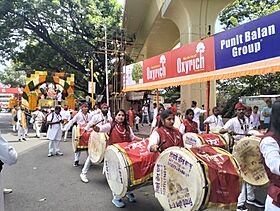
Pune has a strong tradition of theatre, both experimental and professional. The city has several prominent theatres like the Tilak Smarak Ranga Mandir and Bal Gandharva Ranga Mandir.
The Ganesh Kala Krida Rangamanch is the largest indoor theatre in Pune. The Sawai Gandharva Sangeet Mahotsav is a very famous Indian classical music festival held every December in Pune. The idea of Diwāḷī Pahāṭ (Diwali dawn), a music festival on Diwali morning, also started in Pune.
Festivals in Pune
Ganesh Chaturthi is a very popular festival celebrated publicly in Pune. Lokamanya Bal Gangadhar Tilak started the public celebration in 1892 to bring people together. During the festival, large Ganesh idols are set up across the city. Many groups perform shows with music and dancing. These shows often share important social messages. Dhol-Tasha pathaks (groups playing drums) are a big part of the celebrations.
Pune's Food
Puneri misal is a popular vegetarian dish in Pune. Other famous foods include Poha, Upma, Vada Pav, Bhel, Pani Puri, Dabeli, Sabudana vada, and Pav Bhaji. Bakarwadi, a popular snack, was first made in Pune in the 1960s.
Getting Around Pune
Air Travel
Pune International Airport at Lohagaon is one of India's busiest airports. It shares its runways with the Indian Air Force. The airport has flights to major Indian cities and international flights to Dubai and Singapore. In 2018, Pune International Airport was ranked third best for airports with 5–15 million passengers.
A new international airport has been planned because the current one is getting too busy. A location in Purandar has been chosen, and the project is moving forward.
Public Transport in Pune
Public transport in Pune includes the Pune Suburban Railway, bus services by PMPML, and auto rickshaws. Ride-sharing services like Uber and Ola Cabs also operate here. The Pune Metro, a rapid transit system, started limited services in 2022. More lines are being built, including one connecting the Hinjawadi IT hub.
Trains in Pune
The Pune Suburban Railway connects Pune to Pimpri-Chinchwad and the hill station of Lonavala. Daily express trains link Pune to many major cities across India. Pune Railway Station is managed by the Pune Railway Division.
Bus Services in Pune
Buses within Pune and its suburbs are run by Pune Mahanagar Parivahan Mahamandal Limited (PMPML). In 2019, Pune became the first Indian city to use e-buses.
PMPML also runs the Rainbow BRTS system, which was India's first bus rapid transit system. It was designed to have special bus lanes for faster travel.
The Maharashtra State Road Transport Corporation runs buses from Pune to other cities and towns in Maharashtra and nearby states. Private companies also offer bus services.
Pune Metro
The Pune Metro is a mass rapid transit system that is being built. As of March 2022, 12 km (7.5 miles) of two lines are open. Two lines are being built by MahaMetro. Line 1 will go from Pimpri Chinchwad to Swargate, and Line 2 from Ramwadi to Vanaz.
Line 3, connecting Hinjawadi and Civil Court, is also being built. The Civil Court station will be a large interchange station where passengers can easily switch between different metro lines.
Road Transport in Pune
Pune is well-connected to other cities by national and state highways. National Highway 48 links Pune to Mumbai and Bangalore. The Mumbai Pune Expressway, built in 2002, is India's first six-lane high-speed expressway. It has cut travel time between Pune and Mumbai to just over two hours. A ring road is also planned around the city.
Major highways connecting Pune:
Personal Transport in Pune
Pune was once known as the "cycle city of India." However, the number of motorized two-wheelers has grown very fast. In 2018, there were more vehicles than people in the city!
Efforts have been made to bring back cycling. There are plans for 470 km (292 miles) of cycle tracks. Cycle-sharing schemes have also started. Cycling is seen as a good way to connect to the metro system.
Education in Pune
Pune has over a hundred educational institutes and many universities. The Savitribai Phule Pune University (SPPU) is one of the largest universities in India. Many international students, especially from the Middle East and African countries, come to Pune for higher education. Pune is also the biggest center for learning Japanese in India. Other languages like German and French are also taught here.
Schools in Pune
The Pune Municipal Corporation (PMC) runs many primary and secondary schools. Public schools mostly teach in Marathi, but some also offer English, Urdu, and Kannada. Private schools offer more choices, including Hindi and Gujarati. They can follow different education boards.
Jnana Prabodhini Prashala is the first school in India for intellectually gifted students. Pune also has UWC Mahindra College, one of the 18 United World Colleges globally.
Colleges and Universities in Pune
Most colleges in Pune are part of the Savitribai Phule Pune University (SPPU). The College of Engineering Pune, founded in 1854, is one of Asia's oldest engineering colleges. Fergusson College, founded in 1885, is also very well-known.
The ILS Law College is one of India's top law schools. The Armed Forces Medical College and B. J. Medical College are among the best medical colleges. The Film and Television Institute of India is one of only three Indian film schools in a global network.
Symbiosis International University has many colleges in Pune, including top management and law institutes. The Symbiosis Institute of Computer Studies and Research promotes open source technology.
Research Centers in Pune
Pune is home to many government and non-government research institutes. They study a wide range of subjects, from arts to sciences. The Ministry of Defence also has several defense-related training and research centers here.
Some major research centers include:
- Agharkar Research Institute (ARI)
- Armament Research Development Establishment (ARDE)
- Armed Forces Medical College (India) (AFMC)
- Automotive Research Association of India (ARAI)
- Bhandarkar Oriental Research Institute (BORI)
- Central Water and Power Research Station (CW&PRS)
- Centre for Development of Advanced Computing (C-DAC)
- Defence Research and Development Organisation (DRDO)
- Film and Television Institute of India (FTII)
- Gokhale Institute of Politics and Economics
- Indian Institute of Science Education and Research, Pune (IISER, Pune)
- Indian Institute of Tropical Meteorology (IITM)
- Inter-university Centre for Astronomy & Astrophysics (IUCAA)
- National AIDS Research Institute (NARI)
- National Centre for Cell Science (NCCS)
- National Chemical Laboratory (NCL)
- National Defence Academy (NDA)
- National Institute of Virology (NIV)
Media in Pune
Many Marathi-language newspapers from the British era, like Kesari and Sakal, are still published. Sakal is the most popular Marathi daily. Major English newspapers like the Indian Express and Times of India also have Pune editions.
The government-owned All India Radio (AIR) has been broadcasting from Pune since 1953. Savitribai Phule Pune University has its own FM radio channel called Vidyavani. Many commercial FM channels are also available. Pune receives almost all Indian television channels.
Sports in Pune
The modern game of badminton actually started in Pune! It was even called Poona or Poonah back then. The first rules for the game were written here in 1873.
Pune hosts tennis tournaments, including the ATP 250 Maharashtra Open, which is India's biggest professional tennis event.
Popular sports in Pune include cricket, athletics, basketball, badminton, field hockey, football, tennis, kabaddi, and chess. The Chhatrapati Shivaji Stadium in Balewadi is used for wrestling and other traditional sports. The Royal Connaught Boat Club is one of several boating clubs on the Mula-Mutha river.

The Neharu Stadium has hosted games for the 1996 Cricket World Cup and the 2023 Cricket World Cup.
The Pune International Marathon is an annual race. Pune hosted the National Games in 1994 and the 2008 Commonwealth Youth Games at the Balewadi Stadium. The Maharashtra Cricket Association Stadium has hosted international cricket matches. The Pune Race Course, built in 1830, hosts horse races from July to October.
Sports Teams in Pune
The Maharashtra cricket team plays in domestic cricket competitions. Pune has also had teams in the Indian Premier League (IPL), like Pune Warriors India and Rising Pune Supergiant. The Poona District Football Association (PDFA) has over 100 registered teams. FC Pune City was an Indian Super League football club.
Pune also has a basketball team, the Pune Peshwas, and an American football team, the Pune Marathas.
| Club | Sport | League | Stadium | Span |
|---|---|---|---|---|
| Pune Marathas | American football | EFLI | Deccan Gymkhana Ground | 2012–present |
| Pune FC | Association football | I-League | Shree Shiv Chhatrapati Sports Complex | 2007–2016 |
| DSK Shivajians FC | Association football | I-League | Shree Shiv Chhatrapati Sports Complex | 1987–2017 |
| Bharat FC | Association football | I-League | Shree Shiv Chhatrapati Sports Complex | 2014–2015 |
| FC Pune City | Association football | Indian Super League (ISL) | Shree Shiv Chhatrapati Sports Complex | 2014–2019 |
| Pune FC Academy | Association football | Indian Super League (ISL) | Youth League (India) | 2011–2016 |
| Pune 7 Aces | Badminton | Premier Badminton League | Shree Shiv Chhatrapati Sports Complex | 2016–present |
| Pune Pistons | Badminton | Indian Badminton League | Shree Shiv Chhatrapati Sports Complex | 2016–present |
| Pune Peshwas | Basketball | UBA | Deccan Gymkhana Ground | 2015–present |
| Maharashtra cricket team | Cricket | Ranji Trophy | Maharashtra Cricket Association Stadium | 1934–present |
| Pune Warriors India | Cricket | Indian Premier League (IPL) | Maharashtra Cricket Association Stadium | 2011–2014 |
| Rising Pune Supergiant | Cricket | Indian Premier League (IPL) | Maharashtra Cricket Association Stadium | 2016–2017 |
| Puneri Bappa | Cricket | Maharashtra Premier League (MPL) | Maharashtra Cricket Association Stadium | 2023–present |
| Veer Marathi | Cricket | Celebrity Cricket League (CCL) | Maharashtra Cricket Association Stadium | 2013–2015 |
| Maratha Warriors | Hockey | Premier Hockey League (PHL) | Mahindra Hockey Stadium | 2005–2008 |
| Puneri Paltan | Kabaddi | Pro Kabaddi League | Shree Shiv Chhatrapati Sports Complex | 2014–present |
| Pune Marathas | Tennis | Champions Tennis League | Shree Shiv Chhatrapati Sports Complex | 2014–2015 |
Pune's Global Connections
Pune has "twin city" or "sister city" relationships with several cities around the world. This means they share cultural and economic ties.
- Twin towns and sister cities
 San Jose, California, United States (1992)
San Jose, California, United States (1992) Vacoas-Phoenix, Mauritius
Vacoas-Phoenix, Mauritius Austin, Texas, United States – since 2018
Austin, Texas, United States – since 2018 Fairbanks, Alaska, United States
Fairbanks, Alaska, United States Matteson, Illinois, United States
Matteson, Illinois, United States Kawasaki, Japan
Kawasaki, Japan Winnipeg, Canada
Winnipeg, Canada Tromsø, Norway
Tromsø, Norway
- Informal relationship
See also
 In Spanish: Pune para niños
In Spanish: Pune para niños


